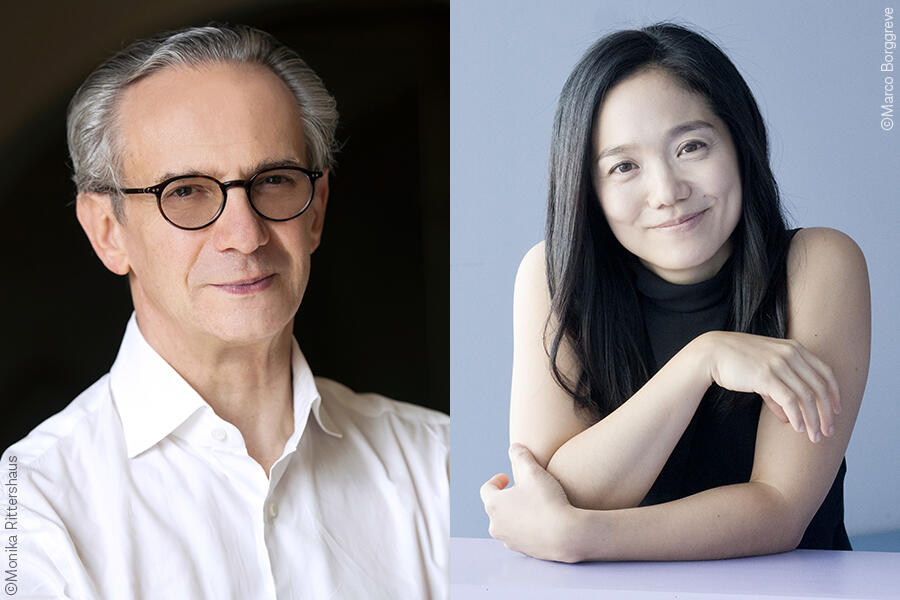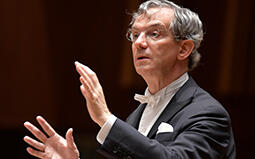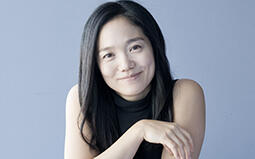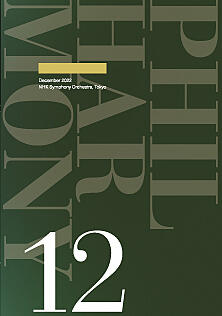- Home
- Concerts
- Subscription Concerts 2022-2023
- Program B
- No. 1973 Subscription (Program B)
No. 1973 Subscription (Program B)

Program
Glinka / Ruslan and Lyudmila, opera – Overture
Fascinated by folk melodies of his homeland, Glinka blazed the trail of the distinct Russian style in classical music previous to younger compatriots including Mussorgsky (1839–1881) and Rimsky-Korsakov (1844–1908).
Ruslan and Lyudmila (1842) is based on the poem of the identical title by Aleksandr Pushkin. Set in Kiev(Kyiv) during medieval times, this fairy-tale opera starts with the wedding feast for Ruslan, knight, and Lyudmila, daughter of the Grand Prince. The festivity takes a sudden turn when the sorcerer Chernomor abducts the bride. As the Grand Prince promises that whoever can rescue Lyudmila will be given her hand, Ruslan and his rivals go on a journey to find her.
The overture is Glinka’s best-known orchestral piece. After the brief introduction, strings sing at speed the festive main theme derived from the opera's finale where all celebrate the united title roles. Towards the conclusion, we hear bassoons and trombones reciting the odd, descending whole-tone scale—a rare example of its use well before Debussy—which is associated with the evil, magical Chernomor. Overall, this buoyant curtain-raiser already foretells the opera's happy ending.
Rakhmaninov / Piano Concerto No. 2 C Minor Op. 18
Rakhmaninov lived a stormy life. After leaving his beloved native land following the 1917 Russian Revolution, he spent the rest of his days in exile and passed away in the USA.
A key work of his pre-exile period, Piano Concerto No. 2 was composed in 1900–1901. Its successful first performance was for him the exit of the long tunnel, for he had suffered from deep depression and writer's block since the fiasco of the 1897 premiere of his Symphony No. 1. He dedicated the Concerto to the physician and hypnotist Nikolai Dahl who treated him to restore his confidence.
The Concerto is a typical example of Rakhmaninov's profoundly Romantic style. It is known as a tremendously difficult piece for pianists, as the composer wrote it for himself who was a top piano virtuoso with phenomenally large hands.
The opening movement is in sonata form. Piano solo prefaces it with a solemn eight bars showing how deeply Russian church bells engraved in Rakhmaninov's mind. Then strings state the first weighty, wavy theme in the home key. The E-flat-major second theme introduced by piano is a tenderer and more lyrical nature. The middle movement has also a rief preamble followed by A–B–A form. Flute and then clarinet give the mellifluous main tune for the A section. As if breaking a stillness, the next movement begins with a march-like brilliant introduction. In this finale, two opposed moods alternate due to two main elements recurring: the effervescent first theme with staccato is launched immediately by piano, and later the placid second theme appears on oboe and violas before being sung by piano with a resounding voice. The Concerto heads toward an exultant C-major conclusion.
Dvořák / Symphony No. 9 E Minor Op. 95, From the New World
Immersed in native Bohemian folklore, Dvořák developed Czech school in classical music; moreover, three years he spent in the New Continent were to lend an individual but friendly allure to his already matured style. The reason behind it was an appointment as the director of the new National Conservatory of Music in New York City. He led a stimulating life there discovering African American music, Native American culture and the country's majestic nature. And new experiences encouraged him to pen the Ninth Symphony.
Since its 1893 premiere in New York, the Ninth has been a favorite of favorites with concertgoers around the world. One of the factors contributing to such popularity may be its abundance of inventive melodies. On this point, the composer utilizes pentatonic (fivenote) scales and syncopated (displacement of accents) rhythms which are common features of different kinds of folk tunes.
The Ninth is in four movements. After a slow proem, horns instantly give the opening movement's first theme like a fanfare. This running-up syncopated motif will recur in three other movements as a unifying element. The bucolic second theme (G minor) first stated by winds famously lacks its leading note (F-natural instead of F-sharp) evoking a folk dance. Also, the third main melody (G major) first sung by flute solo is said to be the unconscious reminiscent of the renowned African American spiritual song Swing Low, Sweet Chariot. As for the slow movement, the composer admitted that he was inspired by a funeral scene from The Song of Hiawatha, Longfellow’s epic poem about Native American characters. Dvořák's original nostalgic melody played as an English horn solo was so widespread that, after his death, it became the spiritual-style song Goin' Home. The Scherzo movement is, according to Dvořák, related to a dance scene from, again, The Song of Hiawatha. The last sonata movement has the brave march-like first theme announced by horns and trumpets, and the gentler second theme revealed by a clarinet. This enthusiastic finale reaches an atypical ending, as the last chord gradually decreases the volume as though the composer's thoughts went to a faraway place.
Artists
 ConductorFabio Luisi
ConductorFabio Luisi
Fabio Luisi hails from Genoa. He is the Principal Conductor of the Danish National Symphony Orchestra and the Music Director of the Dallas Symphony Orchestra. From September 2022, he assumed the position of Chief Conductor of the NHK Symphony Orchestra, Tokyo.
Fabio Luisi was Principal Conductor of the Metropolitan Opera in New York, General Music Director of the Opernhaus Zürich, Principal Conductor of the Wiener Symphoniker, as well as General Music Director of the Staatskapelle Dresden and the Sächsische Staatsoper, Artistic Director and Principal Conductor of the MDR Sinfonieorchester Leipzig, and Music Director of the Orchestre de la Suisse Romande. He is Music Director of the Festival della Valle d’Itria in Martina Franca (Apulia) and has appeared as guest conductor with numerous renowned ensembles, including the Philadelphia Orchestra, the Cleveland Orchestra, the Münchener Philharmoniker, the Filarmonica della Scala, the London Symphony Orchestra, the Concertgebouworkest, and the Saito Kinen Orchestra, as well as with various prominent opera orchestras.
Important recordings include Verdi, Bellini, Schumann, Berlioz, Rachmaninov, RimskyKorsakov, Frank Martin, and Franz Schmidt, the largely forgotten Austrian composer. In addition, he has recorded various symphonic poems by Richard Strauss, and a lauded reading of Bruckner’s Symphony No. 9 with the Staatskapelle Dresden. His recordings of Wagner’s Siegfried and Götterdämmerung with the Metropolitan Opera Orchestra won Grammy awards.
 PianoHisako Kawamura
PianoHisako Kawamura
Hisako Kawamura performs over a wide range of genres as soloist in recitals and concerts and also in chamber music concerts in Europe, especially in Germany, where she is based, and in Japan. In 2019, which
marked the 15th anniversary of her debut, she unrolled a recital series titled Beethoven Piano Sonata Project and released three albums.
She played piano for the lead character, Aya Eiden, in the movie Listen to the Universe (Japanese title Mitsubachi to Enrai) depicting an international piano competition, and made headlines. In 2022, she focused on Schubert's late sonatas, thus continuing her efforts to delve deeper into the subjects of her interest. As a concert soloist, she has worked with many renowned orchestras including the Wiener Philharmoniker, the Moscow Virtuosi Chamber Orchestra, the City of Birmingham Symphony Orchestra, the Czech Philharmonic and the Hungarian National Philharmonic Orchestra. This is her sixth collaboration with the NHK Symphony Orchestra since her !rst appearance in 2010. She came under the international limelight after winning the 2nd prize in the 2006 ARD International Music Competition in Munich and the 1st prize at the 2007 Clara Haskil International Piano Competition. Among numerous awards she has received are the Idemitsu Music Award, the Chopin Society Award in Japan and the 51st Suntory Music Award. She has also injected e#orts in teaching young artists as a professor at the Folkwang University of the Arts and a specially appointed lecturer at the Tokyo College of Music.
Download
Ticket
Program B
No. 1973 Subscription (Program B)
Suntory Hall
Google Map
Seating Chart
Single Tickets Release Date
Pre-sales for Subscribers:Thursday, October 27, 2022
*about subscribers
Sale to General Public:Sunday, October 30, 2022
Price
| S | A | B | C | D | |
|---|---|---|---|---|---|
| Ordinary Ticket | 9,800 | 8,400 | 6,700 | 5,400 | 4,400 |
| Youth Ticket | 4,500 | 4,000 | 3,300 | 2,500 | 1,800 |
Seating chart Enlarge Print PDF
*tax included
*About Youth tickets (Available at N-Kyo Guide)
*Subscribers receive a 10% discount (Available at NHKSO WEB Ticket and N-Kyo Guide)
*For wheelchair-accessible seats, please refer to the N-Kyo Guide
Starting Dates of Ticket Sales
ANNUAL SUBSCRIPTION TICKETS Mon., July 18, 2022 11:00am
[For Subscribers: Thu., July 14, 2022 11:00am]
Youth Tickets
Youth Tickets are great options for those of 25 years old and younger
WEB Select 3 Plus
Choose three or more of your favorite concerts and get a discount on single tickets
*Only available at NHKSO WEB Ticket NHKSO WEB Ticket (Accesible from Japan only)
For further information and subscription application
N-Kyo Guide TEL:0570-02-9502


